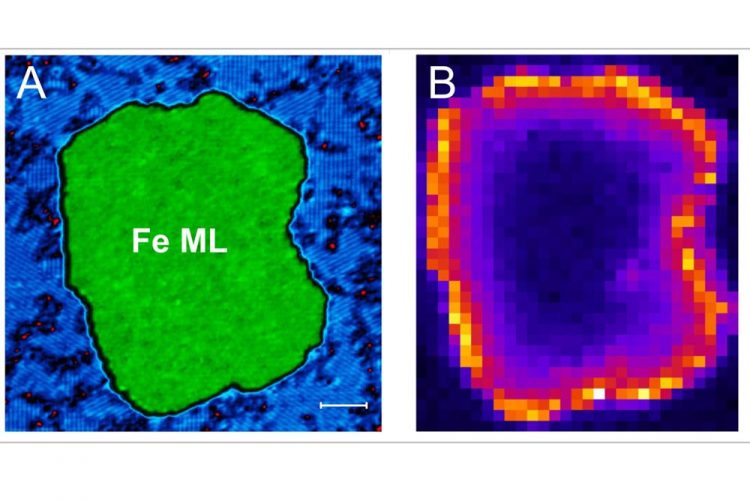Imaging of exotic quantum particles as building blocks for quantum computing

A. A monolayer of iron atoms assembled on a rhenium surface. B. Image of a Majorana fermion as a bright line along the edge of the iron using a scanning tunneling microscope. Credit: UIC/Dirk Morr
Researchers at the University of Illinois at Chicago, in collaboration with their colleagues at the University of Hamburg in Germany, have imaged an exotic quantum particle — called a Majorana fermion — that can be used as a building block for future qubits and eventually the realization of quantum computers. Their findings are reported in the journal Science Advances.
More than 50 years ago, Gordon Moore, the former CEO of Intel, observed that the number of transistors on a computer chip doubles every 18 to 24 months. This trend, now known as Moore's Law, has continued to the present day, leading to transistors that are only a few nanometers — one-billionth of a meter — in size.
At this scale, the classical laws of physics, which form the basis on which our current computers work, cease to function, and they are replaced by the laws of quantum mechanics. Making transistors even smaller, which has been used in the past to increase computing speed and data storage, is, therefore, no longer possible.
Unless researchers can figure out how to use quantum mechanics as the new foundation for the next generation of computers.
This was the basic idea formulated in 1982 by Richard Feynman, one of the most influential theoretical physicists of the 20th century. Rather than using classical computer bits that store information encoded in zeros and ones, one would devise “quantum bits” — or qubits for short — that would utilize the laws of quantum mechanics to store any number between 0 and 1, thereby exponentially increasing computing speed and leading to the birth of quantum computers.
“Usually, when you drop your cell phone, it doesn't erase the information on your phone,” said Dirk Morr, professor of physics at UIC and corresponding author on the paper. “That's because the chips on which information is stored in bits of ones and zeros are fairly stable. It takes a lot of messing around to turn a one into a zero and vice versa. In quantum computers, however, because there is an infinite number of possible states for the qubit to be in, information can get lost much more easily.”
To form more robust and reliable qubits, researchers have turned to Majorana fermions — quantum particles that occur only in pairs.
“We only need one Majorana fermion per qubit, and so we have to separate them from each other,” Morr said.
By building qubits from a pair of Majorana fermions, information can be reliably encoded, as long as the Majoranas remain sufficiently far apart.
To achieve this separation, and to “image” a single Majorana fermion, it is necessary to create a “topological superconductor” — a system that can conduct currents without any energy losses, and at the same time, is tied into a “topological knot.”
“This topological knot is similar to the hole in a donut: you can deform the donut into a coffee mug without losing the hole, but if you want to destroy the hole, you have to do something pretty dramatic, such as eating the donut,” Morr said.
To build topological superconductors, Morr's colleagues at the University of Hamburg placed an island of magnetic iron atoms, only tens of nanometers in diameter, on the surface of rhenium, a superconductor. Morr's group had predicted that by using a scanning tunneling microscope, one should be able to image a Majorana fermion as a bright line along the edge of the island of iron atoms. And this is exactly what the experimental group observed.
“Being able to actually visualize these exotic quantum particles takes us another step closer to building robust qubits, and ultimately quantum computers,” Morr said. “The next step will be to figure out how we can quantum engineer these Majorana qubits on quantum chips and manipulate them to obtain an exponential increase in our computing power. This will allow us to address many problems we face today, from fighting global warming and forecasting earthquakes to alleviating traffic congestion through driverless cars and creating a more reliable energy grid.”
###
Eric Mascot and Sagen Cocklin of the University of Illinois at Chicago; Alexandra Palacio-Morales, Howon Kim and Roland Wiesendanger of the University of Hamburg and Stephan Rachel of the University of Melbourne are co-authors on the paper.
This work was supported by the European Research Council Advanced Grant ASTONISH (project no. 338802) and ADMIRE (project no. 786020); the Alexander von Humboldt Foundation; the U.S. Department of Energy, Office of Science, Basic Energy Sciences, under award no. DE-FG02-05ER46225; and the Australian Research Council (FT180100211).
Media Contact
All latest news from the category: Information Technology
Here you can find a summary of innovations in the fields of information and data processing and up-to-date developments on IT equipment and hardware.
This area covers topics such as IT services, IT architectures, IT management and telecommunications.
Newest articles

“Nanostitches” enable lighter and tougher composite materials
In research that may lead to next-generation airplanes and spacecraft, MIT engineers used carbon nanotubes to prevent cracking in multilayered composites. To save on fuel and reduce aircraft emissions, engineers…

Trash to treasure
Researchers turn metal waste into catalyst for hydrogen. Scientists have found a way to transform metal waste into a highly efficient catalyst to make hydrogen from water, a discovery that…

Real-time detection of infectious disease viruses
… by searching for molecular fingerprinting. A research team consisting of Professor Kyoung-Duck Park and Taeyoung Moon and Huitae Joo, PhD candidates, from the Department of Physics at Pohang University…





















